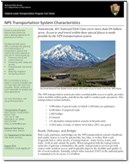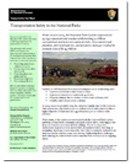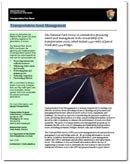
Transportation System Characteristics (pdf 1.12 Mb)
Access to and travel within the special places within the National Park Service are made possible by the NPS transportation systems. This vast system provides essential public access to parks, provides visitor mobility within parks, and allows the staff to conduct park operations.
Waster-Based Transportation Systems
Water transportation alternatives improve visitor access to attractions inside NPS units and surrounding gateway communities. Many visitors come to enjoy the variety of water recreational opportunities that many NPS units provide, including fishing, boating, and swimming. Park staff can also use water transportation to provide interpretive tours and other educational services. As visitation to national park units increases, the resulting traffic congestion causes air and noise pollution, haze, and impacts to cultural and natural resources including dunes, beaches, marshes, and freshwater areas. Water-based transportation alternatives help further NPS sustainability efforts.
Air and Noise Benefits of Alternative Transportation Systems
Growing national park visitation exacerbates traffic congestion and associated air and noise pollution. Pollution also comes from outside sources, including nearby and distant power plants and industries. Air pollutants have quantifiable effects on visibility, ecology, human health, and the economy of gateway communities surrounding parks. Cars, buses, and other motorized vehicles are among the most dominant and pervasive sound sources in national park units. Visitors find that many parks contain significant levels of noise and air pollution, and traffic congestion similar to that found on the city streets they left behind.
Intelligent Transportation Systems
Visitation to national park units is expected to grow over the coming years, leading to increased traffic congestion on park roads and in parking areas. Along with causing visitor frustration, traffic congestion can result in air and noise pollution, haze, and impacts to fragile natural and cultural resources. To help improve the visitor experience, NPS is beginning to use Intelligent Transportation Systems (ITS), which are advanced information and communications technologies that can improve transportation safety and efficiency. ITS technologies include traffic detectors, weather sensors, computer databases, and variable message signs.
Revegetation Program
Natural landscapes are a major feature of many national parks. Natural and human-caused events can disturb vegetation to the point where natural recovery is simply not possible. When that happens, NPS personnel must do more than “preserve and protect.” They must find ways to help re-establish and restore the landscapes and related ecosystems. The Transportation Revegetation Program provides necessary assistance to ensure the protection and conservation of native vegetation using best management practices for the natural landscape.
Trails
NPS assists in trail development by managing components of the National Trails System. This network spans thousands of miles throughout the park system and is comprised of the following trail designations:- National Scenic Trails - Scenic trails are dedicated primarily to foot travel and other non-motorized uses. Each Scenic Trail is over 100 miles in length and they often cross state lines.
- National Historic Trails - These trails commemorate historic and prehistoricroutes, and are of significance to the entire Nation.
- National Recreation Trails - Recreation trails provide numerous outdoorrecreation activities in a variety of urban, rural, and remote areas. This network alone features over 1,000 trails in all 50 states.

Transportation Safety
The National Park Service (NPS) is committed to improving the safety record of its roadways and parkways. As part of its Safety Management System activities, the NPS recently completed a service wide analysis of motor vehicle crash data to determine the severity, type, and distribution of motor vehicle crashes. The patterns identified are helping NPS develop safety strategies that can be implemented to reduce the risk of future crashes. These safety enhancement can include such actions as constructing safety wedges (a 45 degree slope on the outside edge and centerline of the pavement) as part of resurfacing projects; enhancing pavement markings and warning signs; and installing rumble strips at appropriate locations.
Alternative Fuels
To help improve air quality, decrease noise, preserve natural resources, and enhance the visitor experience, NPS is using alternative fuels to power park vehicles and alternative transportation systems (ATS) at many NPS units. Alternative fuels are clean-burning fuels that can power motor vehicles, buses, boats, and trams. Alternative fuel vehicles tend to be more efficient than gasoline or diesel vehicles and they emit nearly 90 percent fewer toxins and ozone-forming hydrocarbons.
Context Sensitive Solutions
Context sensitive solutions (CSS) are a set of collaborative, interdisciplinary approaches to planning that ensures transportation facilities fit in well with their physical setting and preserve scenic, aesthetic, historic and environmental resources while maintaining safety and mobility. CSS is a method that considers the total context within which a transportation improvement project will exist. Designers went to great lengths to make sure that park roads would "lie lightly on the land," impinging as little as possible on their natural and cultural surroundings. By designing roadways that employ graceful curves, naturalistic landscaping and attractive rustic features, the National Park Service is able to showcase its park scenery and most treasured resources.
Emergency Relief for Federally Owned Roads Program
ERFO was established to provide funding and engineering services to help Federal land management agencies that have received serious damage due to natural or manmade disasters or a catastrophic failure. ERFO funds are meant to restore the transportation system back to pre-disaster conditions. NPS units file an application for ERFO funds after a disaster through their Regional Federal Lands Highway Program Coordinators. The damaged road must meet the $700,000 threshold and must be deemed eligible for ERFO funds based on ERFO policy before approval is given to award funds to repair the road.
Asset Management
Transportation Asset Management is a strategic framework for making cost-effective decisions about allocating resources (funding and personnel) and managing infrastructure (physical assets such as roads, equipment, and buildings). It is based on a process of monitoring the physical condition of assets, predicting deterioration over time, and providing information on how to invest in order to maintain or enhance the performance of assets over their useful life. The goals of a transportation asset management program are to minimize the life-cycle costs for managing and maintaining transportation assets, including pavements, bridges, tunnels, rails, and roadside features.
Economic Benefits of Transportation Investment
The roads, parking lots, buses, trams, ferries, bikeways, walking trails, and other components of transportation systems in the National Parks are essential to their vitality. High capacity parking lots and shuttle buses support high rates of visitation at destination parks like Grand Canyon and Yosemite. Shuttle bus service and walking facilities in parks like Acadia open access to urban and foreign visitors without automobile access. Transportation assets can also be key attractions, such as Cuyahoga Valley's bikeways and Glacier Park's Going-to-the-Sun Road.
Bicycle and Pedestrian Trails
Infrastructure for pedestrians and bicycles plays an integral role in a visitor’s experience. Itserves a critical function: providing non-motorized access to areas unreachable by motorized travel. Bicycling, hiking, and walking are all effective alternatives to motor vehicle travel. The National Park Service (NPS) is using these and other transportation alternatives to accommodate more visitors, alleviate congestion, protect park resources, promote physical activity, and enhance the overall experience.

Pavement Preservation Programs
The NPS transportation program has adopted the proactive maintenance approach of pavement preservation. This approach calls for keeping good roads in good condition, rather than allowing them to fully deteriorate through their lifecycle. The focus is on strategies that preserve and maintain existing good roads, extending their lifespan.Last updated: April 4, 2018
